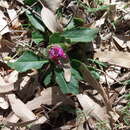pms
nòm ant ël fil


Senecio pulcher is an ornamental plant native to the wet valleys & slopes and flooded rocky[2] habitats in Argentina, Brazil, and Uruguay. Cited in Flora Brasiliensis[3] by Carl Friedrich Philipp von Martius. After dusty miller (S. cineraria), S. pulcher is perhaps one of the most popular species of the genus for horticulture along with German ivy (Senecio mikanioides) and purple ragwort (Senecio elegans) or it was in 1917.[4]
A robust 2 feet (0.61 m) to 4 feet (1.2 m) tall[4] erect herb perennial with a stem[2] covered with 'cobwebby' hairs. Its scarce leaves 4 inches (10 cm) to 10 inches (25 cm) long, shallow lobes along the margin with teeth and a thick taper at the tip.[4]
The late summer inflorescence very striking;[2] the radiate flower heads, 2 inches (5.1 cm) to 3 inches (7.6 cm) across with many long red-purple rays and a yellow disc.[4]
Senecio pulcher grows at altitudes between 0 feet (0 m) and 2,600 feet (790 m)[5] in Southern Brazil, Uruguay and the southern mountains in Argentina.[4]
Senecio pulcher is grown as an ornamental plant in the United States and Europe; flowering in late summer;[2] it is known to be hardy in southern New England in protected places with well drained soils,[4] but its beauty can be marred by frost and bad weather.[6]
A native perennial, as a captive, S. pulcher is an annual who is hesitant to ripen its seed;[6] the gardeners continue the species with inch long root cuttings over-wintered in a pan of light sandy soil in a greenhouse.[6][7]
{{cite web}}: |author= has generic name (help) Senecio pulcher is an ornamental plant native to the wet valleys & slopes and flooded rocky habitats in Argentina, Brazil, and Uruguay. Cited in Flora Brasiliensis by Carl Friedrich Philipp von Martius. After dusty miller (S. cineraria), S. pulcher is perhaps one of the most popular species of the genus for horticulture along with German ivy (Senecio mikanioides) and purple ragwort (Senecio elegans) or it was in 1917.
Senecio pulcher es una especie de planta ornamental; endémica de Argentina, Brasil y Uruguay.
Esta especie es citada en Flora Brasiliensis por Carl Friedrich Philipp von Martius.
Se la halla en suelos anegados de valles, laderas húmedas y vertientes. Es adventicia en lugares rocosos y anegados
Es una herbácea perenne, estival, erecta. Posee rosetas basales con 4-12 hojas por roseta, tallos muy hojosos, hojas delgadas, finas, de 3 x 0,5 cm, las superiores pequeñas, pecíolo de 17 a 24 mm. Inflorescencia compuesta, llamativa, bellísima, muy grande, flores centrales amarillentas y marginales liguladas de color purpureo intenso. Florece antes de otoño. Se la cultiva como ornamental en muchas regiones del mundo.
Senecio pulcher fue descrita por Hook. & Arn. y publicado en Journal of Botany, being a second series of the Botanical Miscellany 3: 337. 1841.[1]
Ver: Senecio
pulcher: epíteto latíno que significa "preciosa".[2] Sinonimia:
Senecio pulcher es una especie de planta ornamental; endémica de Argentina, Brasil y Uruguay.
Esta especie es citada en Flora Brasiliensis por Carl Friedrich Philipp von Martius.
Senecio pulcher adalah spesies tumbuhan yang tergolong ke dalam famili Asteraceae. Spesies ini juga merupakan bagian dari ordo Asterales. Spesies Senecio pulcher sendiri merupakan bagian dari genus Senecio.[1] Nama ilmiah dari spesies ini pertama kali diterbitkan oleh Hook. & Arn..
Senecio pulcher adalah spesies tumbuhan yang tergolong ke dalam famili Asteraceae. Spesies ini juga merupakan bagian dari ordo Asterales. Spesies Senecio pulcher sendiri merupakan bagian dari genus Senecio. Nama ilmiah dari spesies ini pertama kali diterbitkan oleh Hook. & Arn..
Senecio pulcher là một loài thực vật có hoa trong họ Cúc. Loài này được Hook. & Arn. miêu tả khoa học đầu tiên năm 1841.[1]
Senecio pulcher là một loài thực vật có hoa trong họ Cúc. Loài này được Hook. & Arn. miêu tả khoa học đầu tiên năm 1841.